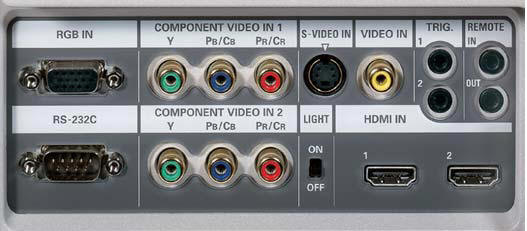Introduction
Last year I had the opportunity
to
review the Marantz VP12S4 720p DLP projector. I've seen quite a few 720p projectors over the last few years, and the S4 was
definitely one of the most impressive.
While I did ponder using the S4 as my
new reference display, I knew that 1080p DLP projectors were right around the
corner, and purchasing in a 720p display might not be the wisest long-term
investment. While 720p is still very good, I needed the 1080p native
resolution for reviewing scalers and next generation video players.
1080p DLP
Last year, Texas Instruments
launched their new single chip 1080p digital mirror device (DMD). 1080p is not
new to DLP, but for awhile, tricks were employed to get this level of
resolution.
The latest DMDs actually use a panel that consists of 1920 mirrors
horizontally and 1080 mirrors vertically. That amounts to a massive 2,073,600
pixels of information on the screen. This also represents the highest level
of HD in the ATSC specification.
Until now, most digital displays
have been limited to 720p (1280x720) which was a nice step up from standard
definition but short of the full capabilities of HD. Broadcast television and
cable have been delivering a mix of HD content including 1080i and 720p but
have not jumped to broadcasting 1080p as of yet.
1080p is
essentially a progressive version of 1080i. This is very similar to what we
saw some years ago when progressive scan DVD players came out. 1080i uses
interlaced fields that update 60 times per second, so really you are only seeing about 540 lines of vertical resolution on
the screen at any one instant. This is
only about 60 more lines than what you see from a progressive scan SD DVD player
(640x480),
but you still get significantly more information in the horizontal domain. DVD
uses 720 lines of horizontal resolution while even 1080i displays use the full
1920 lines of the HD specification (as long as the display can actually
resolve it). For a detailed explanation of the differences between all of the
various resolutions, check out our
article on 1080p.
When I
compared the image quality of the 12S4 to the 11S1 on the same screen, I was
surprised by the differences. The first time I tried the comparison I had a
78" diagonal screen. Sitting at about 1.8x from the screen (1.8 x screen
width) there was a slight difference in resolution, but it wasn't as big as
one may think. It came down to the smallest details in the image, but I think
some people would have been hard pressed to see enough difference to justify
the expense. Moving on to a 120" diagonal screen and sitting about 1.5x away,
the difference was far greater. There is no doubt that the larger the image
you display, the more resolution becomes a critical factor. With the 720p
display I could start to see pixel structure resulting in a more "digital"
look. Fine detail was also a bit smeared when compared directly to the 11S1.
The 12S4 still performed better than I would have expected, but the 11S1
definitely had the more refined, detailed image.
The biggest
improvement to my eye was the lack of motion blur in the image. My chief
complaint with the 12S4 was the subtle amount of image blur I would see with
fast motion from side to side. It only did it on occasion, but it did it
enough to be distracting. The new 1080p DMDs use a completely different motor
to drive the panels, and they are a lot faster. I used a couple scenes where
this motion blur was particularly noticeable, and it was completely gone with the 11S1. I
would have justified the upgrade from that alone.
The Design
The 11S1 is
very similar to the 12S4 in form and function. The chassis is just about
identical with the only really difference noticeable being the color of some
of the plastic. This is a rather large DLP projector and it is also quite
heavy. A custom Konika/Minolta lens is used (like the S4) and this projector
has the same manual vertical lens shift and manual focus. I was a bit
disappointed with the fact that Marantz didn't include a powered focus with
the 11S1, but the manual adjustment does allow for a finer adjustment than some
of the projectors I've used in the past. This is important if you want to use
the full potential of the optics.
The back
panel is also identical to the S4. Marantz has provided two HDMI inputs (1.3a
compliant), two component inputs, and support for S-Video and Composite video.
An RS-232 port is also included along with a VGA input. There is a small light
that can be toggled on or off for connecting in the dark, a feature that I
found quite handy.

The biggest thing missing in the 11S1 compared to the 12S4
is the integrated colorimeter. The VP12S4 had a colorimeter built in
to a lens cap for calibration of gray scale. While this meter wasn't highly
accurate, it did provide the end user with an option
when a professional calibration wasn't desired. Marantz decided not to include
this lens cap and removed the software allowing the calibration.
While it isn't a deal breaker for me in any way, I am surprised that they
opted out of this feature considering the price point of this projector. While
we always recommend a professional calibration by a trained and certified
calibrator, it was a convenient way to hold over until that could be done.
Go to Part II.